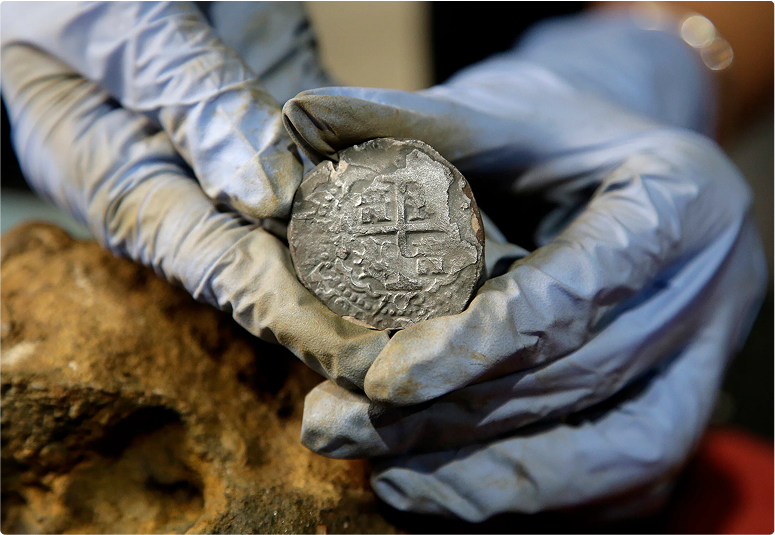
Ahoy, treasure hunters and coin enthusiasts! Prepare to embark on a thrilling journey through the captivating realm of shipwreck coins. From the glittering Spanish doubloons to the weathered ancient silver pieces, these submerged treasures have tales to tell that are as rich as their monetary value. So, batten down the hatches and let's dive into the depths of numismatic adventure!
Sunken Treasures: A Brief History
The allure of shipwreck coins isn't just about their shiny surfaces or hefty price tags. It's about the stories they carry—stories of daring voyages, catastrophic storms, and the ebb and flow of empires. These coins are time capsules, preserving moments of history in their metallic embrace.
The Ship of Gold: SS Central America
Picture this: It's 1857, and the SS Central America is cutting through the waves, its hold brimming with freshly minted gold coins from the California Gold Rush. Suddenly, a hurricane strikes, and the ship plunges to the ocean floor, taking its golden cargo with it.
Fast forward to the 1980s, and this maritime tragedy becomes a modern-day treasure hunt. The recovery of the SS Central America's bounty is the stuff of legends. Among the haul? A treasure trove of $20 gold pieces, now coveted by collectors worldwide. Talk about a golden opportunity!
Spanish Galleons: The Original Treasure Ships
Long before the SS Central America met its watery fate, Spanish galleons ruled the seas. These floating fortresses were the FedEx of their day, shuttling vast wealth across the oceans. But here's a jaw-dropping fact: Over 1,000 Spanish galleons sank during Spain's 300-year reign over the Americas. That's a lot of doubloons taking an unexpected detour to Davy Jones' locker!
These shipwrecks have become underwater gold mines for modern treasure hunters. Spanish doubloons, with their distinctive shield and cross design, are among the most sought-after coins in the numismatic world. It's like owning a piece of a real-life pirate's treasure chest!
Spanish doubloons and gold chains recovered from shipwrecks

El Cazador: The Shipwreck That Changed History
Sometimes, a shipwreck can alter the course of history. Enter El Cazador, the Spanish brig whose sinking in 1784 had consequences far beyond its immediate loss. This ship was carrying a fortune in silver pesos, destined to shore up the economy of Spanish Louisiana.
But when El Cazador vanished beneath the waves, it took with it Mexico's hopes of purchasing the Louisiana Territory. The result? Spain sold Louisiana to France, who then sold it to the United States in the famous Louisiana Purchase. Talk about a butterfly effect—or should we say, a shipwreck effect?
Admiral Gardner: East India Company's Sunken Treasure
In 1808, the Admiral Gardner set sail from England, laden with coins minted by the British East India Company. Fate, however, had other plans, and the ship sank off the English coast. Fast forward to 1985, and divers recovered some of these coins, each bearing the distinctive coat of arms of the East India Company.
These coins are more than just currency—they're tangible links to the era of colonial trade empires. Holding one is like grasping a piece of the complex tapestry of global commerce in the 19th century.
The Coins: More Than Just Currency
Shipwreck coins come in all shapes, sizes, and metals. Let's take a closer look at some of the stars of this underwater numismatic show:
Spanish Doubloons: The Gold Standard
The Spanish doubloon is the rock star of shipwreck coins. These gold coins were the global currency of their day, accepted from the ports of Europe to the markets of Asia. Finding a well-preserved doubloon is like hitting the numismatic jackpot—it's a golden ticket to the past!
A gold coin from Mexico dated 1715, likely a Spanish doubloon

Ancient Silver Coins: Whispers from Antiquity
Not all shipwreck coins are from the age of tall ships and pirates. Some vessels from ancient times have yielded silver coins that provide invaluable insights into ancient economies and trade routes. Imagine holding a coin that might have passed through the hands of Roman merchants or Greek philosophers!
An ancient silver coin displaying a profile and inscriptions

East India Company Coins: Colonial Currency
The coins from shipwrecks like the Admiral Gardner offer a unique window into the world of colonial trade. These coins, with their distinctive designs, tell the story of one of history's most powerful corporations and its role in shaping global commerce.
The Market: Treasure Hunting in Modern Times
The world of shipwreck coins isn't just for underwater archaeologists and museum curators. It's a thriving market that attracts collectors from all walks of life. The rarity and historical significance of these coins often translate into impressive price tags.
But buyer beware—the world of shipwreck coins can be as treacherous as the high seas. That's where reputable dealers come in. Companies like TreasureCoins, managed by Belleair Coins, Gold & Diamonds, have been navigating these waters since 1973. They're the trusted captains in this sea of numismatic treasures, helping collectors add authentic pieces of maritime history to their collections.
Wrapping Up: The Enduring Allure of Shipwreck Coins
From the golden doubloons of Spanish galleons to the silver coins of ancient shipwrecks, these submerged treasures continue to captivate our imagination. They're more than just bits of metal—they're tangible connections to our past, each with a story as deep and mysterious as the oceans they were rescued from.
So, the next time you see a shipwreck coin, remember: you're not just looking at a piece of currency. You're peering through a porthole into history, catching a glimpse of daring voyages, tragic disasters, and the ebb and flow of empires. And who knows? With a bit of luck and a good eye, you might just find your own numismatic treasure. Happy hunting, landlubbers!
 727-585-4502
727-585-4502



